

The Chemistry of Dienes and Polyenes. Volume 2
Edited by Zvi Rappoport
Copyright 2000 John Wiley & Sons, Ltd.
ISBN: 0-471-72054-2
CHAPTER 7
Electrophilic additions to dienes and polyenes
CINZIA CHIAPPE
Dipartimento di Chimica Bioorganica e Biofarmacia, Universita` di Pisa, Via Bonanno 33, 56126 Pisa, Italy
Fax: 39 050 43321; e-mail: cinziac@farm.unipi.it
and
MARIE-FRANCOISE¸ RUASSE
Institut de Topologie et de Dynamique des Systemes` de l’Universite´ Paris 7-Denis Diderot, associe´ au CNRS, UPRESA 7086, 1, rue Guy de la Brosse, 75005 Paris, France
Fax: 33 1 44276814; e-mail: ruasse@paris7.jussieu.fr
I. INTRODUCTION . . . . . . . . . . . . . . . . . . . . . . . . . . . . . . . . . . . . . |
546 |
|
II. ELECTROPHILIC HYDROGEN . . . . . . . . . . . . . . . . . . . . . . . . . . . |
549 |
|
A. Addition of Water and Carboxylic Acids . . . . . . . . . . . . . . . . . . . . |
549 |
|
B. Addition of Hydrochloric Acid, Hydrocyanic Acid and Hydrogen |
|
|
SulÞde . . . . . . . . . . . . . . . . . . . . . . . . . . . . . . . . . . . . . . . . . . |
553 |
|
III. ELECTROPHILIC CARBENIUM IONS . . . . . . . . . . . . . . . . . . . . . . |
558 |
|
IV. ELECTROPHILIC HALOGENS AND POSITIVE HALOGEN |
|
|
DONORS . . . . . . . . . . . . . . . . . . . . . . . . . . . . . . . . . . . . . . . . . . |
560 |
|
A. General Aspects . . . . . . . . . . . . . . . . . . . . . . . . . . . . . . . . . . . . |
560 |
|
B. Fluorine . . . . . . . . . . . . . . . . . . . . . . . . . . . . . . . . . . . . . . . . . |
561 |
|
C. Chlorine . . . . . . . . . . . . . . . . . . . . . . . . . . . . . . . . . . . . . . . . . |
564 |
|
1. |
Conjugated double bonds . . . . . . . . . . . . . . . . . . . . . . . . . . . . |
564 |
2. |
Non-conjugated double bonds . . . . . . . . . . . . . . . . . . . . . . . . . |
571 |
D. Bromine . . . . . . . . . . . . . . . . . . . . . . . . . . . . . . . . . . . . . . . . . |
572 |
|
1. |
Conjugated double bonds . . . . . . . . . . . . . . . . . . . . . . . . . . . . |
572 |
2. |
Non-conjugated double bonds . . . . . . . . . . . . . . . . . . . . . . . . . |
580 |
E. Iodine . . . . . . . . . . . . . . . . . . . . . . . . . . . . . . . . . . . . . . . . . . . |
585 |
|
1. |
Conjugated double bonds . . . . . . . . . . . . . . . . . . . . . . . . . . . . |
585 |
2. |
Non-conjugated double bonds . . . . . . . . . . . . . . . . . . . . . . . . . |
588 |
545
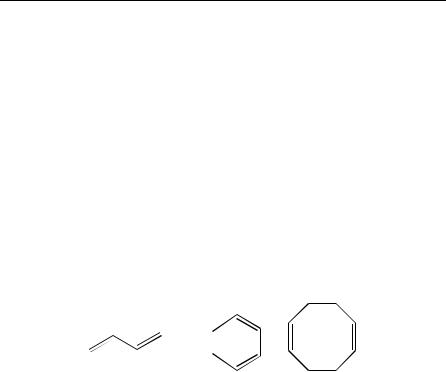
546 |
Cinzia Chiappe and Marie-Franücoise Ruasse |
|
V. ELECTROPHILIC SULFUR AND SELENIUM . . . . . . . . . . . . . . . . . |
597 |
|
A. Sulfenyl Halides and Related Compounds . . . . . . . . . . . . . . . . . . . |
597 |
|
1. |
General aspects . . . . . . . . . . . . . . . . . . . . . . . . . . . . . . . . . . |
597 |
2. |
Conjugated double bonds . . . . . . . . . . . . . . . . . . . . . . . . . . . . |
599 |
3. |
Non-conjugated double bonds . . . . . . . . . . . . . . . . . . . . . . . . . |
606 |
B. Selenenyl Halides and Related Compounds . . . . . . . . . . . . . . . . . . |
614 |
|
1. |
General aspects . . . . . . . . . . . . . . . . . . . . . . . . . . . . . . . . . . |
614 |
2. |
Conjugated double bonds . . . . . . . . . . . . . . . . . . . . . . . . . . . . |
614 |
3. |
Non-conjugated double bonds . . . . . . . . . . . . . . . . . . . . . . . . . |
616 |
VI. ELECTROPHILIC MERCURY . . . . . . . . . . . . . . . . . . . . . . . . . . . . |
625 |
|
A. General Aspects . . . . . . . . . . . . . . . . . . . . . . . . . . . . . . . . . . . . |
625 |
|
B. Conjugated Double Bonds . . . . . . . . . . . . . . . . . . . . . . . . . . . . . |
627 |
|
C. Non-conjugated Double Bonds . . . . . . . . . . . . . . . . . . . . . . . . . . |
631 |
|
VII. CONCLUSIONS . . . . . . . . . . . . . . . . . . . . . . . . . . . . . . . . . . . . . . |
637 |
|
VIII. ACKNOWLEDGMENTS . . . . . . . . . . . . . . . . . . . . . . . . . . . . . . . . |
638 |
|
IX. REFERENCES . . . . . . . . . . . . . . . . . . . . . . . . . . . . . . . . . . . . . . . |
638 |
|
I. INTRODUCTION
Electrophilic additions to carbon Ð carbon double bonds, a very large chapter in any organic textbook1, have been for a long time2 and recently3 the object of intensive research because of their interest in fundamental mechanistic approaches, synthetic methodology and industrial procedures. In this context, the electrophilic reactions of dienes and polyenes have been reviewed frequently in speciÞc paragraphs of extensive reports2 on the reactivity of carbon Ð carbon bonds and, sometimes, more speciÞcally4 as a particular class of unsaturated compounds exhibiting properties markedly different from that of monoethylenic compounds. When there is no interaction between the several double bonds included in a polyenic molecule, the reactivity of each of these bonds toward usual electrophiles is not altered by the presence of other double bonds. No particular attention will be paid in this review to this category of polyenes since many previous reports on electrophilic reactivity covered the Þeld2. In contrast, when two or more ethylenic bonds interact, a particular reactivity of the system is expected. The present review on studies carried out over the last 25 years is focused on this second category which involves mainly acyclic and cyclic conjugated 1,3-dienes, derived from 1 and 2, respectively, and non-conjugated cyclic dienes, cis,cis-1,5-cyclooctadiene (3) being the most popular representative in this series.
(H2C)n
(1) |
(2) |
(3) |
The few kinetic results and the extensive product data on the electrophilic reactions of these dienes have been mainly interpreted in terms of the simplistic mechanism described in equation 1 and postulated by analogy to that established a long time ago5 for the reactions of monoethylenic compounds. According to this naive picture, an ionic intermediate with two possible limiting structures would be formed by electrophilic addition
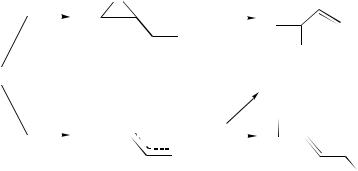
7. Electrophilic additions to dienes and polyenes |
547 |
of the molecule EY to one of the two double bonds, viewing the dienic system as a monoethylenic compound substituted by a conjugated vinyl group. This approach was actually justiÞed very early by the pioneering work of Tidwell and coworkers6 in their extensive kinetic investigation of the acid-catalyzed hydration of ethylenic compounds, including a number of substituted 1,3-dienes. The rates of addition to the conjugated dienes Þtted fairly well the general structure Ðreactivity relationship for monoenes when the appropriate substituent constant for the vinyl group was used. Unfortunately, no further studies have been undertaken to support the reliability of this conclusion for other electrophiles. It is also surprising that the numerous recent details and improvements of the general mechanism for electrophilic additions to monoenes2d,3,7 (including the role of charge transfer complexes, the reversibility of the intermediate-forming step, the solventindependent bridging and nucleophilic solvent assistance, etc.) have not been extended to reactions of dienes.
|
+EY |
|
E |
|
|
|
|
|
|
E |
|
|
|
+ |
|
|
, |
Y− |
|
|
|
||||
|
|
|
|
|
Y |
|
||||||
|
|
|
|
|
|
|
|
|
|
|||
|
|
|
|
|
|
|
|
|
|
|||
|
|
|
|
|
|
|
|
|
|
|||
|
|
|
|
|
|
|
|
|
|
|
|
|
|
|
|
|
|
|
|
|
|
|
|
|
|
1 |
|
|
|
|
|
|
|
|
|
1,2-adduct |
|
|
|
|
|
|
|
|
|
|
|
|
|
|
(1) |
|
+EY |
E |
|
|
|
|
|
|
E |
|
||
|
|
|
+ |
, |
Y− |
|
|
|
|
|||
|
|
|
|
|
|
|
|
|||||
|
|
|
|
|
|
|
|
|||||
|
|
|
|
|
|
|
|
|
|
|
||
|
|
|
|
|
|
|
|
|
|
1,4-adduct |
Y |
|
|
|
|
|
|
|
|
|
|
|
|
||
Actually, the main speciÞc feature of the reaction of conjugated dienes has been the competition between 1,2- and 1,4-additions, which has to be associated with the Markovnikov/anti-Markovnikov regiochemistry and the anti vs syn stereochemistry usually exhibited in the monoene reactions2,3,8. The product mixtures obtained from conjugated polyenes are highly complex. Therefore, most of the interest in these reactions was focused on the reaction products and interpretation of their formation in terms of allylic and/or bridged structures of the ionic intermediates. A basic experiment on the deuterium incorporation in 1,3-pentadiene in its reaction with DCl raised this problem very early9. Not only 1,2- but also 1,4-adducts were observed as a result of the fast interconversion of the two isomeric ion pairs (vide infra). From this result and many others emerged the idea of two limiting structures for these intermediates, an allylic carbenium ion with extensive charge delocalization into the second double bond and a bridged cation whose charge is stabilized by the entering electrophile. Therefore, 1,2-adducts would result from nucleophilic trapping of strongly bridged intermediates whereas 1,4-additions would arise from an unbridged allylic carbocation. In agreement with this assumption, signiÞcant amounts of 1,4-adducts were obtained with electrophilic ßuorine10, a poorly bridging atom, while electrophilic sulfur additions which involve an efÞcient bridging afforded mainly 1,2-products11. Moreover, the bridged vinyl-substituted intermediate is expected to lead to a mixture of Markovnikov and anti-Markovnikov addition products. Syn adducts with a predominant Markovnikov regioselectivity should also be obtained from an allylic intermediate. Indeed, the addition of sulfenyl halides to butadienes12 afforded anti 1,2-adducts with either a Markovnikov or anti-Markovnikov regiochemistry,
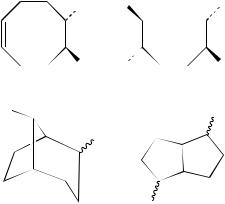
548 |
Cinzia Chiappe and Marie-Franücoise Ruasse |
consistent with a vinyl-substituted thiiranium ion intermediate. Analogously, 1,2-bromine adducts were found to be mainly anti13 whereas the 1,4-products were formed nonstereoselectively.
Nevertheless, the product data have been exceptionally interpreted only in these terms.
(i) An allylic carbocation can afford signiÞcant amounts of 1,2-products. For instance, in the above-mentioned DCl addition, 1,2-adducts were the major products whatever the solvent. (ii) In addition to the electrophile and substituent dependence of the charge distribution in the intermediate, solvent and steric effects probably play an important role in the product-forming step of these reactions, as they do in the reactions of monoenes7d,8. (iii) 1,2-Adducts isomerize frequently to the more stable 1,4-adducts. Therefore, the kinetic or thermodynamic control of the product distribution12,14 should be questioned. As a consequence, a number of early results were later revised when this problem was recognized. (iv) Finally, it has also been suggested15 that 1,4-addition products do not necessarily arise from allylic intermediates but could also result from bridged intermediates via an SN20 process implying a syn stereochemistry.
The electrophilic additions of reagents EY to non-conjugated cyclic dienes with two interactive double bonds such as in 3 have been also widely investigated because of their potential interest in organic synthesis16 Ð18 and also since they are useful models for hydrocarbon skeleton rearrangements of cyclic carbocations19. Monoand bis-1,2-addition products, 4 and 5, have been sometimes observed when the electrophilic atom was strongly bridging and under poorly ionizing and dissociating conditions, as for example in the reaction20 of methanesulfenyl chloride with 3. However, in most cases and in particular when strong interactions between the positive charge of the intermediate and the second double bond promoted transannular reactions, i.e. parallel and/or cross -cyclizations, rearranged products such as 6 or 7 were usually obtained21 Ð 23.
E Y 
 E
E
Y |
E |
Y |
(4) |
|
(5) |
Y |
|
E |
|
E |
|
(6) |
Y (7) |
The industrial use of 1,3-dienes and of their electrophilic reactions has strongly stimulated the Þeld in recent years. Because of the low cost of butadiene, abundantly available from the naphtha cracking process, very large scale applications in the synthesis of polymers, solvents and Þne chemicals have been developed, leading to many basic raw materials of the modern chemical industry. For example, the primary steps in the syntheses of acrylonitrile and adiponitrile have been the electrophilic addition of hydrocyanic acid to butadiene24. Chlorination of butadiene was the basis of chloroprene synthesis25.

7. Electrophilic additions to dienes and polyenes |
549 |
Its hydration opened the route26 to a large scale production of solvents such as n-butanol and 2-ethylhexanol (>2 million tons in 1990). Most of these processes have involved the use of metal catalysts for activation of the -system. The Þrst catalysts used were mainly expensive noble or environmentally non-friendly metals, such as Rh, Pd or Ni. In this context, a number of works from academic laboratories reported in this review have been devoted to the catalytic activity of various other metals27. Their results on the selectivities of these catalyzed reactions were sometimes surprising and have not yet received consistent mechanistic interpretations.
In more general terms, the present review reports much experimental data, essentially on the distribution of addition products of a large variety of dienes. It is not the intention to provide a comprehensive approach to these highly versatile reactions. Many of the mechanistic interpretations suggested by the authors are still controversial or need to be conÞrmed. This is not surprising since the regioand stereochemical outcome of the monoethylenic compounds reactions which a priori are simpler than those of dienes, is not yet fully understood despite recent signiÞcant progress3,7,8. Nevertheless, most of the presently available results on electrophilic additions to dienes are of great interest in many Þelds of organic chemistry.
II.ELECTROPHILIC HYDROGEN
A.Addition of Water and Carboxylic Acids
At the time when the ASE2 mechanism of the acid-catalyzed hydration of alkenes was Þrmly established2a,c, the reaction of conjugated dienes was also investigated. It was shown that the same mechanism also applied to dienes (equation 2). The Þrst step is generally reversible but, under well-chosen reaction conditions, the formation of an allylic carbocation by proton addition to one of the two double bonds is rate-limiting. The fast trapping of the carbocation by water in the second step affords the two allylic alcohols corresponding either to a 1,2-addition or to a 1,4-addition. Several pieces of evidence supported this mechanism.
|
|
|
|
|
|
|
|
|
|
|
R |
|
|
|
|
|
|
|
OH |
|
|
|
|
|
|
|||||
CH2 |
|
C |
|
CH |
|
CH2 |
|
|
|
|
|
|
|
|
|
|
|
|
|
|
|
|
|
|
|
|
|
|
|
|
|
|
|
|
|
|
C |
+ CH2 |
|
CH3 |
|
|
|
C |
|
|
|
CH |
|
|
CH2 |
||||||||||
|
|
|
|
|
|
|
|
|
|
|
|
|
|
|||||||||||||||||
|
|
|
|
|
|
|
|
|
|
|
CH3 |
|
|
|
|
|
|
|
|
|
|
|
||||||||
|
|
|
|
|
|
|
|
|
|
|
CH |
|
|
|
|
|
|
|
|
|
|
|
|
|
|
|
|
|
||
|
|
R |
|
|
|
|
|
|
|
|
|
R |
+ |
|
(2) |
|||||||||||||||
|
|
|
|
|
|
|
|
|
|
|
|
|
|
|
|
|
|
|
|
|
||||||||||
|
|
|
|
|
|
|
|
|
|
|
|
|
|
|
CH3 |
|
|
C |
|
|
CH |
|
|
CH2OH |
||||||
|
|
|
|
|
|
|
|
|
|
|
|
|
|
|
|
|
||||||||||||||
|
|
|
|
|
|
|
|
|
|
|
|
|
|
|
|
|
|
|
|
|
|
|||||||||
|
|
|
|
|
|
|
|
|
|
|
|
|
|
|
|
|
|
|
|
|||||||||||
|
|
|
|
|
|
|
|
|
|
|
|
|
|
|
|
|
|
|
|
|
|
|
|
|
|
|||||
|
|
|
|
|
|
|
|
|
|
|
|
|
|
|
|
|
|
R |
|
|
|
|
|
|
||||||
(i) The rates of acid-catalyzed hydration of 2-substituted-1,3-butadienes6, CH2DC(R) CHDCH2, R D EtO, c-Pr, Me, H and Cl, Þt the general structure Ðreactivity relationship28 (equation 3) established for the hydration of 1,1-disubstituted alkenes, R1R2CDCH2, under similar reaction conditions, with pC D 0.16 for the vinyl substituent.
log k D 12.3 pC 10.1 |
3 |
(ii) A linear dependence of log k for the hydration of a variety of dienes |
on H0, |
the appropriate acidity function of aqueous solutions of sulfuric and perchloric acids (equation 4), was observed6,29,30, as found also for alkenes. The slopes of these relationships were all close to unity, e.g. D 1.00, 1.16, 1.22, 1.2 and 1.3 for
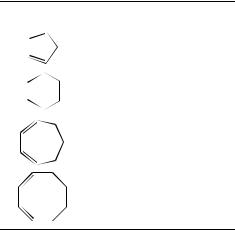
550 Cinzia Chiappe and Marie-Franücoise Ruasse
chloroprene6, isoprene6, 1,3-butadiene6, 1-Ph-1,3-butadiene29 and 1,3-cyclohexadiene30, respectively.
log kobs D H0 C ε |
4 |
The acidity dependence of the activation enthalpies and entropies, HD6 |
and SD6 , of |
the hydration of 1,3-cyclohexa- and 1,3-cyclooctadienes was ascribed30 to a dielectric solvation effect in dilute acids, which is overcome by increasing solvent structure as the availability of water decreased in concentrated acids. This suggestion was one of the early premises of a more recent interpretation31 of acidity effects in terms of water activity and solvation of cationic species.
(iii) The kinetic isotope effects, kH3OC /kD3OC , for the hydration of 1,3-cyclohexadiene29
and 2-substituted 1,3-butadienes6 were in the range of 1.1 to 1.8, very similar to those observed for the reaction of alkenes.
(iv) The effects of ring size on hydration rates and equilibria for 1,3-cycloalkadienes (C5, C6, C7 and C8 dienes) in aqueous sulfuric acid have been interpreted in terms of changes in free energy of conjugative stabilization of the allylic carbocation32. An approximately linear inverse relationship between strain energy and log khydr was obtained (Table 1). The comparison of these data with those obtained for the hydration of cyclic monoalkenes suggested earlier transition states for the diene hydration than those for the alkene reaction.
The regiochemistry of the acid-catalyzed water addition to cis- (8c) and trans- (8t) 1-ethoxy-1,3-butadienes leading to 9c and 9t, respectively33, has been investigated in deuterium incorporation experiments (equations 5 and 6). The cis-isomer incorporated deuterium at the 2-position as well as the 4-position whereas deuterium was added to the trans-isomer exclusively at the 4-position. This result has been interpreted in terms of equations 7 and 8: -protonation in the trans-isomer was assumed to be controlled mainly by thermodynamic factors whereas ˛-protonation was assumed to arise from charge control
TABLE 1. Effect of ring size on hydration of 1,3- cycloalkadienesa
1,3-Cycloalkadiene |
krelb |
Strain energyc |
|
200 |
0.8 |
|
2000 |
1.2 |
|
4 |
1.4 |
|
1 |
3.8 |
a Data of Reference 32.
b Relative rates of hydration in 1.05 M H2SO4 at 80 ° C. c In kcal mol 1.
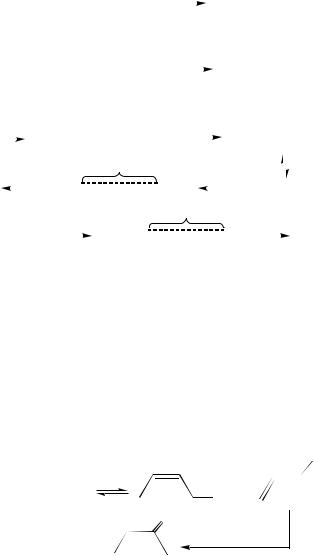
7. Electrophilic additions to dienes and polyenes |
551 |
because the transition state for the trans-isomer is earlier than that for the cis-isomer. This interpretation was supported by the fact that 8t reacted 14 times faster than 8c.
|
|
|
|
|
|
|
D+ |
|||||||
cis-CH2 |
|
CH |
|
CH |
|
CHOEt |
|
CH2D |
|
CH |
|
CD |
|
CHO |
|
|
|
|
|||||||||||
|
|
|
|
|
||||||||||
|
|
|
|
|
|
|||||||||
|
|
|
|
|||||||||||
|
|
|
|
|
|
|
|
(8c) |
|
|
|
|
|
|
|
|
|
|
|
|
|
|
|
1.0 |
|
0.0 |
|
|
0.2 |
|
|
(5) |
|||||||||||||||||||
|
|
|
|
|
|
|
|
|
|
|
|
|
|
|
|
|
|
|
|
|
|
|
|
|
|
|
|
|
|
|
|
||||||||||||||||||||
|
|
|
|
|
|
|
|
|
|
|
|
|
|
|
|
|
|
|
|
|
|
|
|
|
|
|
|
|
|
|
|
|
|
|
|
|
(9c) |
|
|
|
|
|
|
|
|
|
|||||
trans-CH2 |
|
|
CH |
|
|
|
|
CH |
|
|
|
CHOEt |
D+ |
|
|
|
CH2D |
|
|
|
CH |
|
|
CH |
|
|
|
CHO |
|||||||||||||||||||||||
|
|
|
|
|
|
|
|
|
|
|
|
|
|
|
|
|
|
|
|
|
|
|
|||||||||||||||||||||||||||||
|
|
|
|
|
|
|
|
|
|
|
|
|
|
|
|
|
|
|
|
||||||||||||||||||||||||||||||||
|
|
|
|
|
|
|
|
|
|
(8t) |
|
|
|
|
|
|
|
|
|
|
|
|
|
|
|
0.9 |
|
0.0 |
0.0 |
|
(6) |
||||||||||||||||||||
|
|
|
|
|
|
|
|
|
|
|
|
|
|
|
|
|
|
|
|
|
|
|
|
|
|
|
|
|
|
|
|||||||||||||||||||||
|
|
|
|
|
|
|
|
|
|
|
|
|
|
|
|
|
|
|
|
|
|
|
|
|
|
|
|
|
|
|
|
|
|
|
|
|
|
|
|
|
(9t) |
|
|
|
|
||||||
8c |
|
|
|
CH2 |
|
|
|
|
|
|
|
|
|
|
|
|
|
|
|
|
|
+ |
|
|
|
|
|
|
|
|
CH2 |
|
|
|
|
|
|
|
|
|
|
|
|
|
|
|
|
|
|||
|
|
|
|
|
|
CH |
|
|
CHD |
|
|
CHOEt |
|
|
|
|
|
|
|
|
CH |
|
|
CHD |
|
|
|
CHO |
|||||||||||||||||||||||
|
|
|
|
|
|
|
|
|
|
|
|
|
|
|
|
|
|
|
|
|
|
|
|
||||||||||||||||||||||||||||
|
|
|
|
|
|
|
|
|
|
|
|
|
|
|
|
+ |
|
|
|
|
|
|
|
|
|
|
|
|
|
|
|
|
|
|
|
|
|
|
|
|
|
|
|
|
(7) |
||||||
|
|
|
|
|
|
|
|
|
|
|
|
|
|
|
|
|
|
|
|
|
|
|
|
|
|
|
|
|
|
|
|
|
|
|
|
|
|
|
|
|
|
|
|
||||||||
9c |
|
|
|
|
|
|
|
|
|
|
|
|
|
|
|
|
|
|
|
|
|
|
|
|
|
|
|
|
|
|
|
|
|
|
|
|
|
|
|
|
|
|
|
|
|
|
|
|
|
|
|
|
|
CH2D |
|
|
|
|
CH |
|
|
|
CD |
|
|
|
CHOD |
|
|
|
CH2 |
|
|
|
CH |
|
|
CD |
|
|
CHOD |
||||||||||||||||||||||
|
|
|
|
|
|
|
|
|
|
|
|
|
|
|
|
|
|
|
|
|
|
||||||||||||||||||||||||||||||
|
|
|
|
|
|
|
|
|
|
|
|
|
|
|
|
|
|
|
|
|
|
|
|||||||||||||||||||||||||||||
|
|
|
|
|
|
|
|
|
|
|
|
|
|
|
|
|
|
|
|
|
|
|
+ |
|
|
|
|
|
|
|
|
|
|
|
|
|
|
|
|
|
|
|
|
|
|
|
|||||
|
|
|
|
|
8t |
|
|
|
|
|
|
|
|
CH2D |
|
|
|
CH |
|
CH |
|
|
|
CHOEt |
|
|
|
|
|
|
|
9t |
(8) |
||||||||||||||||||
|
|
|
|
|
|
|
|
|
|
|
|
|
|
|
|
|
|
|
|
|
|
|
|
|
|
|
|
|
|
|
|||||||||||||||||||||
|
|
|
|
|
|
|
|
|
|
|
|
|
|
|
|
|
|
|
|
|
|
|
|
|
|
|
|
|
|
|
|||||||||||||||||||||
1,3-butadiene |
was converted34 |
into methyl ethyl ketone with |
a yield |
of 90% in a |
|||||||||||||||||||||||||||||||||||||||||||||||
one-pot synthesis at 155 °C with a conversion rate of 100 mol mol 1 h 1 (100 mol of butadiene per 1 mol of catalyst per hour) in water or in water Ð diglyme mixtures in the presence of a catalytic system involving a 1 : 2 : 14 (molar) ratio of ruthenium(acac)3, 1,10-phenanthroline (Phen) and p-toluenesulfonic acid. Other transition metals (Pd, Rh or Ir) associated to various ligands (e.g. pyridines) with other Bronsted¬ acids (H2SO4, H3PO4, CF3CO2H, HCl, CF3SO3H) also promoted the reaction, but with lower yields and selectivities. The reaction was suggested to occur in two consecutive steps: (i) 1,2- and 1,4-addition of water to 1,3-butadiene and (ii) rearrangement of the formed allylic alcohol, 3-buten-2-ol, into methyl ethyl ketone (equation 9). Formally, the primary allylic alcohol, 2-buten-1-ol, could rearrange into n-butanol. However, this has not been observed and instead, this alcohol which is involved in hydration Ðdehydration equilibrium with butadiene was also converted indirectly into methyl ethyl ketone.
HOTs
1 + H2O
|
|
OH |
OH |
+ |
(9) |
|
|
O
Ru (acac)3
Phen
The Þrst hydration step was promoted by Bronsted¬ acids containing weakly or noncoordinating anions. In the second step, an intramolecular hydrogen transfer in the secondary alcohol was catalyzed by ruthenium(III) salts with chelating bipyridyl-type ligands. The possible complexation of the latter with the diene did not inhibit its catalytic activity in the allylic rearrangements, under acid-catalyzed hydration conditions.
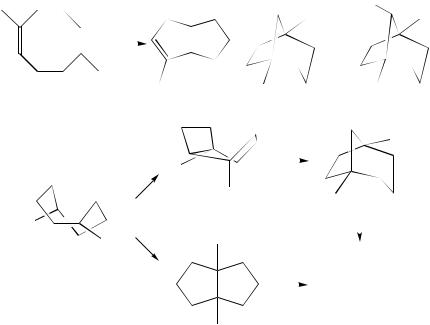
552 |
Cinzia Chiappe and Marie-Franücoise Ruasse |
The procedure worked also with 1,3-octadiene and with isoprene which produced methyl isopropyl ketone in 80 Ð85% yield.
These transformations have been potentially useful at an industrial level35, considering the large-scale availability and application of butadiene and methyl ethyl ketone.
The electrophilic additions of formic and acetic acids to 1,5-dimethyl-1,5-cyclooctadiene yielded mainly23 syn-8-substituted-1,5-dimethylbicyclo[3.2.1]octanes (equation 10) via parallel -cyclization and subsequent Wagner ÐMeerwein (W-M) type rearrangement. Cross -cyclization leading to bicyclo[3.3.0]octane derivatives, which were the major adducts in other electrophilic additions to unsubstituted 1,5-cyclooctadiene21,22 comprised only a minor route. This different behavior has been interpreted (equation 11) in terms of a signiÞcantly larger stability of the tertiary carbocation II than that of the secondary ion III, both ions being the two potential intermediates derived from I by a parallel and a cross -cyclization, respectively.
|
|
|
|
|
|
|
OCOR |
RCOO |
|||
|
|
|
RCO2H |
+ |
|
|
|
+ |
|
|
|
|
|
|
|
|
|
|
|
||||
|
|
|
|
|
|
|
|
|
|
||
|
|
|
|
|
16% |
58% |
|
5% (10) |
|||
|
|
|
|
|
|
|
|
|
+ |
|
|
|
|
|
|
|
+ |
|
W-M |
|
|
|
|
|
|
|
parallel |
|
|
|
|
|
|
||
|
|
|
|
|
|
|
|
|
|
||
+ |
|
|
|
|
II |
|
|
|
IV |
||
|
|
|
|
|
|
|
|
|
|
(11) |
|
|
|
|
|
|
|
|
|
|
|
||
|
|
|
|
|
|
|
|
|
|
|
|
|
|
|
|
|
|
|
|
|
|
|
|
|
|
|
|
|
|
|
|
|
|
||
|
|
|
cross |
|
|
|
Major product |
||||
|
|
|
|
|
+ |
|
|
Minor product |
|||
|
|
|
|
|
|
|
|||||
|
|
|
|
|
|
|
|
|
|
|
|
III
The predominantly syn stereochemistry of the products arising from the bicyclo[3.2.1] octyl cation IV would results from the large ring strain in II, the chair conformation of which, (but not boat) facilitate the Wagner Ð Meerwein type rearrangement.
In a context of industrial interest, the copper-catalyzed addition of acetic acid36 to 1 (hydroacetoxylation) in the absence of oxygen was shown to be non-regioselective, a 1 : 0.5 mixture of 1,2- and 1,4-addition products being obtained in a yield of 60% based on butadiene. The effect of various additives on the regiochemistry and the yield has been carefully studied. The butadiene conversion was mainly efÞcient with the CuBr Ð LiBr catalytic system (equation 12). The role of the catalyst in the reaction mechanism has been discussed but not fully understood. It has been shown that the dominant formation
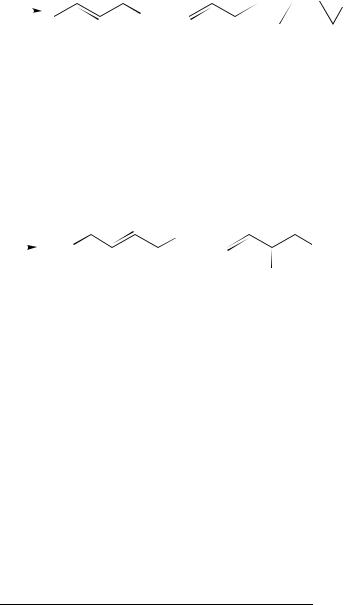
7. Electrophilic additions to dienes and polyenes |
553 |
of the 1,2-isomer during the acetic acid addition was kinetically controlled, the equilibrium mixture of the 1,2- and 1,4-isomers in the presence of the catalyst being 1 : 1. The results were compared with those obtained by the same authors for the hydrocyanation (vide infra) which was markedly more regioselective than hydroacetoxylation.
1 |
HOAc |
OAc + |
+ |
|
OAc |
|
|
||||||
CuBr−LiBr, 73 °C |
|
(12) |
||||
|
|
|
|
|
||
|
|
|
|
OAc |
|
|
20% |
40% |
|
traces |
|||
When this reaction was carried out under oxygen pressure (generally 10 bars) using Cu(OAc)2 in association with LiBr as a catalyst in an acetic acid Ð acetic anhydride (2 : 1) solvent mixture, diacetoxylation37 leading to 1,2- and 1,4-diacetoxyethylenic adducts took place (equation 13). The regioselectivity, which did not depend signiÞcantly on the reaction conditions, was poor in all cases, the 1,4- to 1,2-isomer ratio being close to unity. The formation of the 1,2-isomer seemed to be kinetically controlled, as was found for the hydroacetoxylation. A variety of reaction intermediates, such as an epoxybutene, and in particular hydroxyacetates, has been suggested but the mechanism is far from being elucidated. The absence of regioselectivity is in contrast to that found for the same reaction promoted by much more expensive palladium catalysts38.
|
2 HOAc |
OAc |
|
||
1 |
+ |
OAc (13) |
|||
|
AcO |
||||
Cu(OAc)2−LiBr, O2 |
|||||
OAc
B. Addition of Hydrochloric Acid, Hydrocyanic Acid and Hydrogen Sulfide
The regiochemistry of the addition of DCl to trans-1,3-pentadiene was investigated very early in various solvents in order to understand the competition between 1,2- and 1,4 additions to conjugated dienes9. The results (Table 2) indicated a marked predominance of 1,2-addition. This has been interpreted in terms of ion pairing as described in equation 14, assuming that the addition of undissociated DCl gave the carbenium Ð chloride ion pair with the anion associated at C(2). Interconversion with the isomeric ion pair having the chloride associated with C(4) at a rate not much faster than that of the ion pair collapse would produce the 1,2-adduct in excess of the 1,4-adduct. These results were in contrast with those observed for other electrophilic additions in more dissociating solvents (vide infra).
TABLE 2. Regiochemistry of DCl addition to trans-1,3-pentadienea
Solvent |
T (° C) |
% 1,2-Addition |
% 1,4-Addition |
None |
78 |
75.5 |
24.5 |
|
25 |
61.5 |
38.5 |
Pentene |
78 |
77.7 |
22.3 |
|
25 |
63.8 |
36.2 |
CH3CO2D |
25 |
65.0 |
35.0 |
CH3NO2 |
25 |
67.7 |
32.3 |
a The two adducts result from at least 96% anti addition.
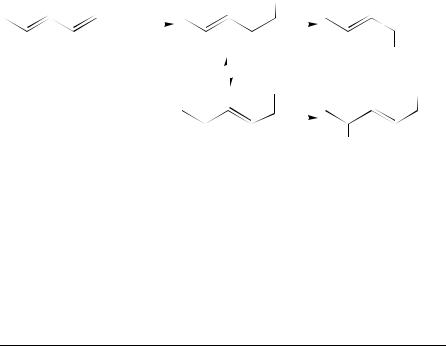
554 |
Cinzia Chiappe and Marie-Franücoise Ruasse |
|
|||||||
|
|
|
|
|
|
D |
D |
||
|
+ DCl |
|
+ |
|
|
|
|||
|
|
|
|
|
|||||
|
|
|
|
|
|
Cl− |
Cl |
||
|
|
|
|
|
|
D |
(14) |
||
|
|
|
|
|
|
||||
|
|
+ |
|
|
D |
||||
|
|
|
|||||||
|
|
|
|
|
|
|
|
||
|
|
|
|
|
|||||
|
|
|
Cl− |
Cl |
|||||
|
|
|
|
|
|
|
|
|
|
The orientation of the addition of HCl to a variety of halogen-substituted 1,3-butadienes has been extensively studied under preparative conditions39 Ð43. The results are given in Table 3. No signiÞcant polymerization was observed and the products were in all cases those resulting from a 1 : 1 addition process. The regiochemistry control by the position of the chlorine atom was quite versatile. A Cl at C(1) favored formation of the 4,3-adduct whereas with Cl on C(2) the 1,4-adduct predominated. The competition between substitution by chlorine and methyl attenuated but did not markedly modify this orientation. However, all these reactions were quite slow and took from 5 to 10 h, even in the presence of a catalyst (mostly cuprous chloride). Therefore, product
TABLE 3. Product distribution in hydrogen chloride addition to halogeno-substituted 1,3-buta- dienes, R1CHDCR2 CR3DCH2
R1 |
R2 |
R3 |
% 1,2- |
% 1,4- |
% 4,3- |
% 4,1- |
% Yielde Conditionsf |
References |
|||||
|
|
|
|
|
Additiona Additionb Additionc |
Additiond |
|
|
|
|
|
||
Cl |
H |
H |
0 |
5 |
78 |
7 |
86 |
|
A |
|
40 |
||
Cl |
H |
H |
0 |
1 |
94 |
5 |
75 |
|
B |
|
40 |
||
H |
Cl |
H |
3 |
97 |
0 |
0 |
Ñ |
|
C |
|
42 |
||
H |
Br |
H |
2 |
85 |
0 |
0 |
Ñ |
|
D |
|
42 |
||
H |
Br |
H |
1 |
73 |
0 |
0 |
Ñ |
|
E |
|
42 |
||
H |
Cl |
Cl |
0 |
90h,i |
0 |
0 |
63 |
|
Fj |
|
41 |
||
Cl |
H |
CH3 |
3 |
9 |
75 |
13 |
90 |
|
E |
|
43 |
||
H |
CH3 |
Cl |
15 |
49 |
3 |
33 |
71 |
|
D |
|
40 |
||
H |
CH3 |
Cl |
3 |
57 |
1 |
39 |
Ñ |
|
E |
|
40 |
||
H |
CH3 |
Cl |
40 |
21 |
8 |
31 |
25 |
|
G |
|
40 |
||
a R1CH2 C(R2)Cl CR3DCH2. |
|
|
|
|
|
|
|
|
|||||
b R1CH2 CR2DCR3 CH2Cl. |
|
|
|
|
|
|
|
|
|||||
c R1CHDCR2 C(R3)Cl CH3. |
|
|
|
|
|
|
|
|
|||||
dR1CHCl CR2DCR3 CH3. |
|
|
|
|
|
|
|
|
|||||
eOverall yield. |
|
|
|
|
|
|
|
|
|
||||
fReaction conditions (in every case, excess of HCl, vigorous stirring): A, 20% HCl |
C |
25% CuCl |
C |
7% NH Cl, |
|||||||||
40 Ð 45 |
° |
|
|
|
|
|
|
|
|
4 |
|||
|
C. B, A without catalyst. C, concentrated hydrochoric acid at constant [HCl], maintained by addition of |
||||||||||||
gaseous HCl, in the presence of catalytic CuCl, at 40 |
°C. D, C without catalyst, at room temperature. E, C at room |
|||
temperature. F, in CCl |
° |
° |
C. |
|
g |
4 in the presence of FeCl3, at |
10 C. G, in ether at 15 |
|
|
|
Substantial amounts (24% and 12%, with and without catalyst, respectively) of 1,3-dichloro-2-butene arising |
|||
from bromine Ð chlorine exchange were formed. h cis C trans.
i5 Ð 15% of 1,2,3,6,7-pentachloro-2,6-octadiene were formed. jIn water, no addition products were formed.
